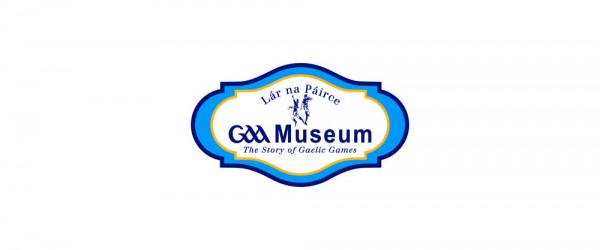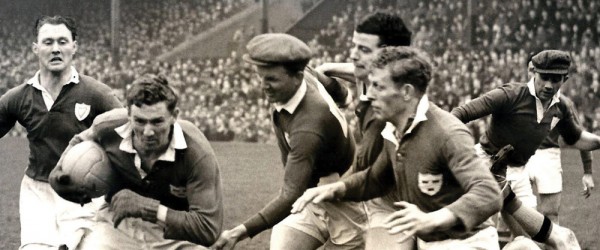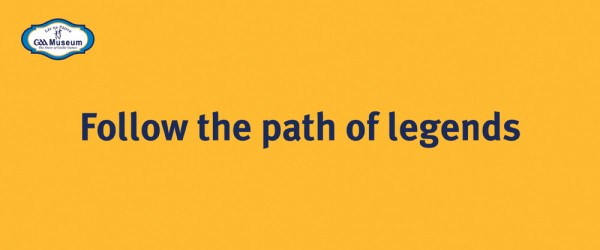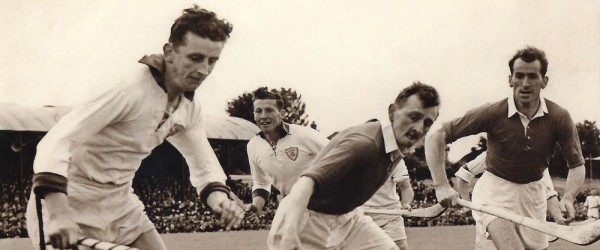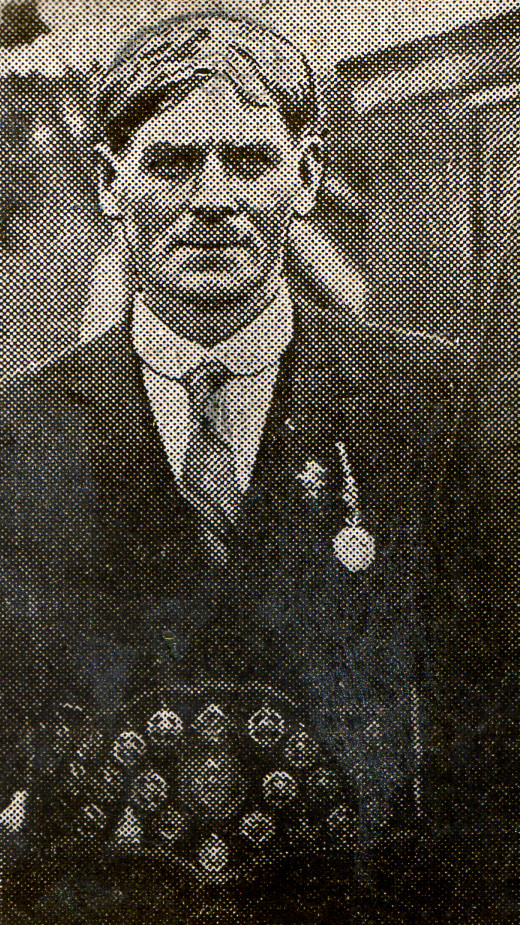No.9
Tim Crowe (1881-1962) and his Medal Belt________________________________________
Tim Crowe trained the Tipperary team on their tour of America in 1926. Forty-five years of age in that year, he carried 44 gold medals won on the track in a green leather belt and wore it on important occasions during the tour. He always slept with the belt under his pillow.
This famous belt, which is on display in Lár na Páirce, contains the record of Crowe’s athletic achievements throughout Ireland over a period of more than twenty years. The belt, which has suffered the ravages of time and movement, is somewhat depleted today with 33 medals and gaps where at least 9 more once rested. The belt and the attached medals are the work of Tim Crowe himself and an indication of the fine workmanship he was capable of.
Crowe may have been influenced by the Lonsdale Belt, which was introduced by the National Sporting Club, the body that controlled boxing in Britain, in 1909 as a new trophy for the British champion at each weight division. In contrast to Crowe’s leather belt the Lonsdale belt was made of porcelain and gold. Championship belts were also a feature of professional running and walking. The earliest account that mentions a championship belt dates back to a race in London in 1851.
This practice of wearing a belt of medals in public might appear strange today but it wasn’t out of place during Crowe’s years. Many of us remember our fathers and grandfathers wearing a medal or two on the watch chain. Of course, military men always festooned their chests with medals on formal occasions, and still do. So, what Crowe did wasn’t extraordinary but perhaps more pronounced than what most people did.
Athletic Achievements
The medals represent Tim Crowe’s athletic achievements and leads one to the record of the national championships he won. There is a major difficulty here because there is no accurate record of what he won. For example, in the report of his death the Tipperary Star said: ‘For 15 years he held the senior individual cross-country championship of Ireland.’ Terry O’Sullivan in his On the Road column in the Irish Press, sometime in 1951, stated: ‘He was never beaten in a cross-country race between 1907 and 1920, won hundreds of prizes for these and uncountable other races, and preserves still a collection of forty-five medals.’
It’s very difficult to establish the authenticity of some of these claims. Two dates are given as the start of Crowe’s athletic career, 1903 and 1906. According to the information in the Register of Births in the Parish of Knockavilla and Donaskeigh, Crowe was born in September 1881. He was a half-twin to John and both were the last children to be born to their parents William Crough (sic) and Bridget Davern. He had five other siblings, James (1868), Mary (1870), Bridget (1872), William (1874) and Anne (1877). This would have made Crowe either 22 or 25 years old at the beginning of his athletic career. (As a matter of interest the censuses of 1901 and 1911 give Crowe’s age as 16 and 26 respectively, which puts his year of birth six years later in 1885!). According to the report on the latter year he won the County Tipperary one-mile championship at Clonoulty in 1906. This victory so impressed members of the Galteemore Athletic Club that he was invited to join. He competed under its colours until 1919, winning many titles from a mile up to marathon distance. He severed his relationship with Galteemore in 1919 and joined Clonliffe Harriers in 1920.
Crowe represented Galteemore in the 5-miles junior championship in the National Cross-Country Championships, held in Clonskeagh on March 2, 1907. As well as winning the team event Galteemore had the first, Crowe, and the second, J. J. Howard (also from Dundrum) in the individual event. This was Crowe’s first national championship.
In 1908 Crowe represented Tipperary at senior level. The team championship fell through and in the senior individual championship only three started. According to T. F. O’Sullivan’s History of the G.A.A., it was won by ‘T. Crough (sic), Tipperary,’ a form of Tim’s name that was occasionally used during his earlier athletic career.
According to the accepted wisdom Crowe won every senior cross-country championship up to 1919, when he had a falling out with the G.A.A. According to Huckleberry Finn, who wrote contemporary newspaper articles on ‘Famous Irish Athletes at Home and Abroad’, the reason for the falling out was over a little matter. Apparently, Crowe was after running a ten mile marathon and, having started from scratch and doing well as usual, he was let hang around for a few hours waiting for his clothes to be brought up to him from the starting point, which could, and should, have been easily done by a cyclist. Instead he had to run back the ten miles to obtain his clothing!
As a result of this falling out, Crowe threw in his lot with the Cross-Country Association of Ireland (CCAI) which was affiliated to the I.A.A.A. hoping to win the cross-country championship of this body and hold an unbeaten record in the two associations. He joined the Clonliffe Harriers and won the junior cross-country championship of Ireland, run at McGowan Park, Belfast. Having won this championship, he now decided to go for the senior cross-country championship. Against a top-class field of the best CCAI men in Ireland and the best Irishmen in England, Scotland and Wales, Crowe ran an outstanding race and beat them all by 300 yards.
These victories would bring to 15 the number of cross-country championships won by Crowe between 1907 and 1920, if we are to accept the claim that he was unbeaten in the period 1908-1919. But the records don’t support the claim and the only definite record we have of senior individual cross-country titles is for the years 1908, 1911, 1912, 1914 and 1915. No race was held in 1909 or 1016. He didn’t run in 1910 or 1913 and I can find no record of 1917, 1918 and 1919.
Crowe also won silver team medals in international cross-country championships in 1920, at Belvoir Park, Belfast on April 3, and 1921, Caerleon Racecourse, Newport, Wales on March 19. The break with the G.A.A. facilitated competing at an international level. There was no international competition under G.A.A. rules.
Other national titles won by Crowe under G.A.A. rules include the following track and field: 2 miles 1908, 4 miles 1910, 2 & 3 miles 1917, 4 miles 1919. He also won some road titles, 5, 10, 15 and 20 miles 1919.
London Marathon
Probably the race that got Tim Crowe the greatest publicity in Ireland was the Polytechnic Marathon from Windsor to Stamford Bridge, organised annually by the London Polytechnic Harriers Club for the ‘Sporting Life’ trophy worth £500. Crowe was one of 46 entries, that included one Swede and one Frenchman in the 1921 race and was 38 years of age at the time. He arrived the day before for the race and hadn’t the time or the means to prepare for the race that his fellow competitors had.
‘No hotels and no masseurs for me,’ he used to say when telling the story. ‘I was my own trainer and I paid my own expenses. On the day before the race I crossed the boat to England and when I arrived in London I hadn’t much time to look at the course because I had to go looking for lodgings.’
London was sweltering in a heatwave, which caused some competitors to drop out, but Crowe kept motoring on and was in touch with the leaders for a long time. After 5 miles, he was a little over a minute behind the leader, two and a half mins after 10 miles, five after 15 miles and approximately twenty after 20 miles. Then an unfortunate thing happened and he went off course for a while but eventually completed the race in 3-24-35 and seventh place, almost thirty-three minutes behind the winner. (He didn’t actually finish the race, running 253/4 miles instead of the 26 miles 385 yards, because he was too far back and the track was crowded when he arrived at the Stadium.)
The picture that emerges of Crowe in accounts written of this event is of a hero, who took on the might of Europe in a foreign city and but for the hand of misfortune on his shoulder, which sent him in the wrong direction towards the end, he might well have come home with the spoils of victory. It is a marvellous picture of a great athlete, overcoming immense obstacles, one of the few to complete the race and disdaining all medical assistance at the end in spite of the sweltering heat.
As one newspaper account put it: ‘Whilst the rest of the competitors fell down on the spot and were being fanned, refreshed with water and massaged – or else being carried off on stretchers – Tim trotted away, donned his clothes and straightway set off for a short holiday in France.’ This was a lion-hearted hero, to cherish and be proud of and he was placed in the pantheon of the greats of Tipperary, with the likes of Matt the Thresher.
It appears that Crowe stopped competing after 1924. In that year, he ran the Templemore to Milestone race for the second time and won it for the second time. Tommy Ryan, who started the Memorial Race in 1986, was fifth. (Crowe’s winning time over the 1919 course, which was 3/4 of a mile short, converted to the full 20 miles distance run in 1986, would have still been good enough to place him 9th in that latter race.) There is a reference somewhere of him doing a run-out with Galteemore Athletic Club in 1931 at Thurles Sportsfield. There was also an episode with Arthur Newton, the English ultra-distance runner, who was open to challenges from athletes to run him in 50 and 100 mile races during the twenties. The account is vague, the time was the spring of 1928 and it suggests that Crowe travelled to London to meet Newton. It came from the Tipperary Star’s Cappawhite correspondent.
Crowe and the Olympics
Tim Crowe never took part in the Olympics and there is no easy answer why he didn’t. The first Olympics in which he might have competed was in London in 1908. The Olympics at this stage of their development weren’t as highly rated as they were to become. In fact, the better athletes regarded the AAA championships more highly. Maybe Crowe was influenced by this attitude. There was also the fact that Crowe ran under G.A.A. rules and he and his fellow athletes did not look beyond the bounds of G.A.A. competition. Another factor was that Irishmen who did compete in the Olympics did so under the IAAA, and Crowe didn’t come under this umbrella until he joined Clonliffe Harriers in 1919. He would have missed the 1912 games at Stockholm and, as there were no games in 1916 because of the war, had to wait until Antwerp in 1920 for the next games. By this stage, he was over the top as an athlete though he could have been a competitor in the marathon. Yet, as his time in the Polytechnic Marathon in 1921 reveals he was way off the pace and would not have been a serious contender for a medal.
A Distinctive Figure
Tim Crowe was a distinctive looking figure. It wasn’t that he was a big man, in fact people who remember him recall him as being about 5 feet 6 inches in height with an exceptionally strong pair of thighs. In the pictures that appeared of him in newspapers he cut a dapper figure with his hair parted in the middle and a moustache, wearing a waistcoat. The belt of medals girded his belly and his often found with the hands in the trousers pockets, holding back the front of his coat better to expose the medals.
When he was in his cycling gear he wore knee-length knickerbockers with stockings coming up to just under his knees. The chain wheel on his bicycle was bigger than usual which allowed him to travel at a faster speed on the flat but which made climbing hills more difficult. He cut a curious figure on the roads and sometimes a group of cyclists he came across on his journeys would try to pace him but inevitably he overtook them and left them behind. According to a neighbor, he had the habit of walking the bicycle out the lane from where he lived to the road and, if he were heading in Ballagh direction, he would continue walking up the hill half-ways before mounting.
